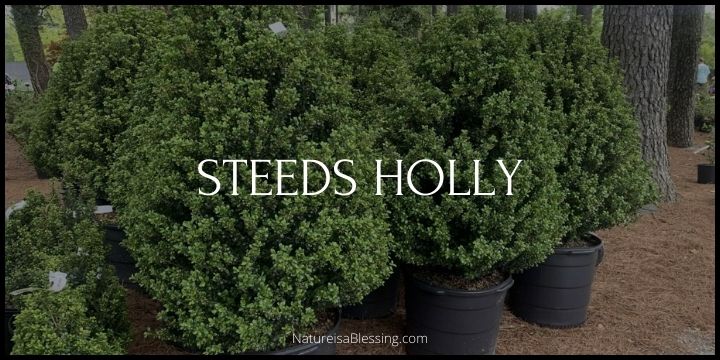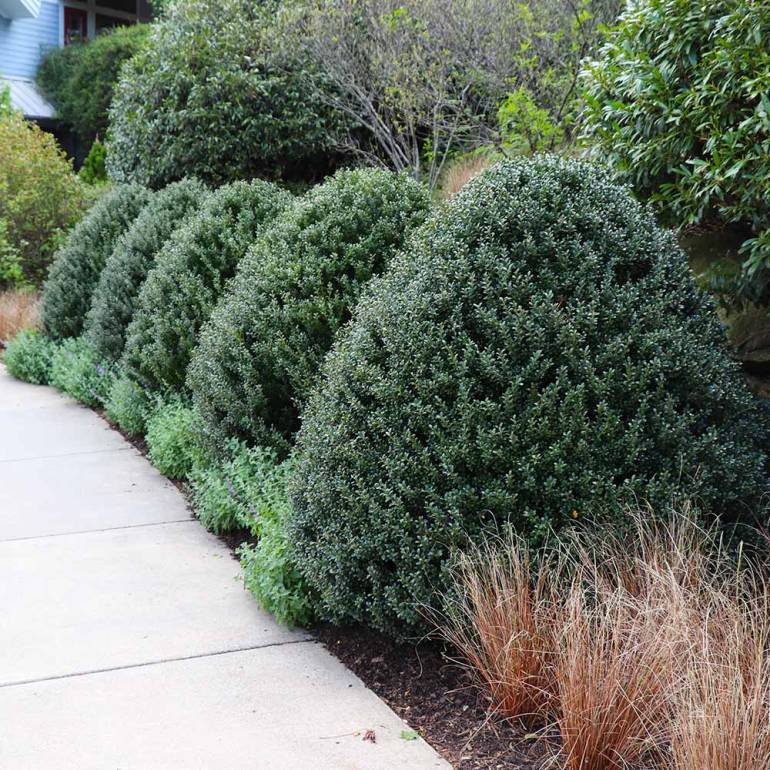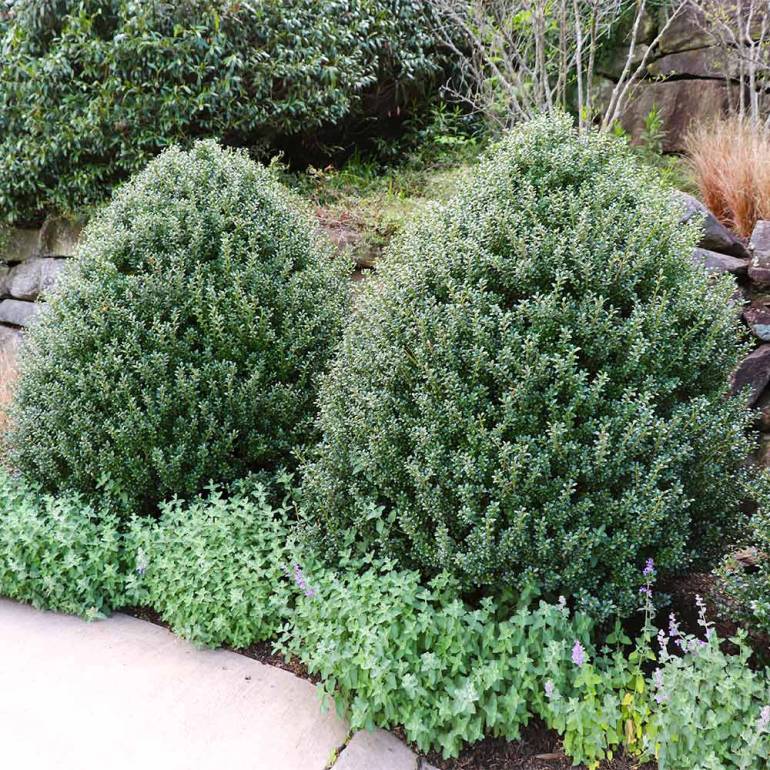Steeds Holly: How to Plant, Grow, and Care

What is Steeds Holly?
Steeds Holly, a captivating evergreen shrub, is a garden gem that adds character to any landscape throughout the year. Originating from diverse regions, including Asia, Europe, and North America, this plant is a member of the Aquifoliaceae family. It belongs to the Ilex Genus, which is renowned for its versatile and hardy nature.
The charm of Steeds Holly lies in its form and foliage. This upright, pyramid-shaped shrub flaunts glossy, dark green leaves that retain their vibrant color even in the depths of winter. The leaves’ unique shape, with their spiny margins, provides a distinct texture, creating an eye-catching contrast in the garden.
One of the most appealing aspects of Steeds Holly is its season of interest. While many plants lose their lustre in winter, Steeds Holly steps into the spotlight. Its showy red berries add a pop of color to the winter landscape, attracting birds and bringing life to the otherwise bare scenery.
Despite its attractive features, Steeds Holly doesn’t demand much maintenance. It thrives in a range of soil types, from sandy and loamy to clay, provided it’s well-drained. It can adapt to full sun or partial shade, and once established, it exhibits a good degree of drought tolerance.
Steeds Holly grows slowly to medium pace, reaching a height and spread of about 6-10 feet. With its dense growth habit, it’s an excellent choice for hedges, screens, or even as a standalone specimen. It’s also a popular pick for topiaries, thanks to its ability to withstand heavy pruning.
In short, Steeds Holly is not just a plant; it’s a testimony to nature’s year-round beauty and resilience. Whether you’re a seasoned gardener or a novice green thumb, this plant will undoubtedly enhance your gardening experience.
Fast Facts About Steeds Holly
| Attribute | Details |
|---|---|
| Country Or Region Of Origin | Asia, Europe, North America |
| Plant Type | Shrub |
| Family | Aquifoliaceae |
| Genus | Ilex |
| Sun Exposure | Full Sun to Partial Shade |
| Season of Interest | Winter (for berries) |
| Water | Medium |
| Maintenance level | Low |
| Growth rate | Slow to Medium |
| Height | 6-10 ft. (1.8-3 m) |
| Spread | 6-10 ft. (1.8-3 m) |
| Spacing | 5-10 ft. (1.5-3 m) |
| Soil Type | Well-drained, Loamy, Sandy, Clay |
| Soil pH | Acidic, Neutral, Alkaline |
| Soil Drainage | Well-drained |
| Habit/Form | Upright or Erect |
| Attracts | Birds (for berries) |
| Characteristics | Evergreen, showy fruits, attractive foliage |
| Tolerance | Drought, Erosion, Air Pollution |
| Suggested Use | Hedges, Screening, Topiary, Wildlife Garden |
| USDA Plant Hardiness Zone | 6-9 |

How to Plant and Grow Steeds Holly
Ideal Planting Conditions
- Soil pH Level: Steeds Holly prefers slightly acidic to neutral soil, with a pH between 5.5 and 7. However, it can also tolerate alkaline soils.
- Sunlight Requirement: This plant thrives in full sun to partial shade, although more sun exposure will lead to denser foliage and more prolific berry production.
- Temperature Range: It’s hardy in temperatures of hardiness zones 6-9, meaning it can withstand minimum temperatures down to -10°F.
- Watering Frequency: While Steeds Holly is somewhat drought tolerant once established, it prefers regular watering, particularly in dry periods. Ensure the soil stays moist but not waterlogged.
When and How to Plant
The best time to plant Steeds Holly is in early spring or fall when the plant is dormant. This gives the plant time to establish its roots before the growing season begins.
When selecting your Steeds Holly, look for healthy plants at a reputable local nursery. Choose plants with vibrant, dark green leaves and no signs of disease or pest infestation. You can buy them as container-grown plants, which are easier to establish than bare-root plants.
Step-by-Step Planting Instructions
- Prepare the Planting Area: Dig a hole twice as wide and just as deep as the root ball of your plant. If your soil is heavy clay, amend it with compost or other organic matter to improve drainage.
- Plant the Holly: Place the plant in the hole, ensuring that the top of the root ball is level with the surrounding soil. Backfill the hole with the excavated soil, firming gently to remove air pockets.
- Water Well: After planting, water thoroughly and apply a layer of mulch around the base of the plant to retain moisture and suppress weeds.
Post-Planting Care
- Watering: Water regularly during the first year to help the plant establish. After that, you can reduce watering, but make sure to water during dry spells.
- Fertilizing: Apply a slow-release fertilizer in early spring to encourage growth. A balanced fertilizer or one designed for acid-loving plants is ideal.
- Pruning: Prune in late winter or early spring before new growth starts. This helps maintain the shape of the plant and encourages bushier growth.
Potential Pitfalls
Watch out for common pests like holly leaf miners and spider mites. If you notice any signs of infestation, such as discolored leaves or webbing, treat with an appropriate insecticide.
Also, be aware of potential diseases like Phytophthora root rot, particularly if your soil doesn’t drain well. This can be prevented by ensuring good drainage at planting time and not overwatering your plant.
When to Prune Steeds Holly?
The best time to prune Steeds Holly is typically in late winter or early spring before new growth begins. This timing helps maintain the plant’s shape and encourages bushier growth.
However, it’s important to cease pruning two months prior to the average first frost date in your area. Pruning can resume in winter when the plants have stopped growing.
For flowering hedges like Steeds Holly, it is safest to prune immediately after flowering so you do not prune away newly forming buds if you wait until later in the season.

Interesting Landscape Ideas for Steeds Holly
| Landscape Idea | Description |
|---|---|
| Hedge Planting | Steeds Holly, with its dense growth habit and uniform shape, makes an excellent hedge plant. You can plant a row of these shrubs to create a living fence, providing both privacy and aesthetic appeal. |
| Foundation Planting | Due to its moderate size and evergreen nature, Steeds Holly is an ideal choice for foundation plantings. It helps hide unsightly parts of the home’s foundation and provides year-round interest. |
| Topiary | With its ability to withstand heavy pruning, Steeds Holly is well-suited to being shaped into topiaries. From simple shapes like spheres and cones to more intricate designs, this versatile shrub can be sculpted to enhance your garden’s visual appeal. |
| Bird Garden | The bright red berries of Steeds Holly attract a variety of birds, making it a perfect addition to a bird garden. Besides providing food for the birds, it also offers shelter with its dense foliage. |
| Mixed Shrub Border | Steeds Holly can be planted alongside other shrubs to create a mixed border. Its glossy, dark green leaves provide a beautiful backdrop for flowering plants, while its winter berries add color during the colder months. |
| Container Planting | Smaller varieties of Steeds Holly can be grown in containers, either as standalone plants or combined with other species. This allows you to enjoy its beauty on patios, balconies, or small spaces where ground planting isn’t possible. |
| Specimen Planting | With its pyramidal shape and attractive foliage, Steeds Holly can serve as a specimen plant in your landscape. It can be used as a focal point in a lawn or garden, drawing attention with its distinctive form and texture. |
What Does Steeds Holly Symbolize?
| Symbol | Description |
|---|---|
| Protection | In many cultures, holly plants are seen as symbols of protection. This belief stems from the plant’s evergreen nature and its thorny leaves, which are thought to ward off evil spirits and negative energy. |
| Immortality | The evergreen nature of the Steeds Holly, like other hollies, symbolizes eternal life or immortality in various cultures, as it stays green throughout the year, even in winter. |
| Christmas Cheer | Holly plants, including Steeds Holly, are often associated with Christmas and winter celebrations. Their bright red berries and dark green leaves symbolize the festive cheer of the holiday season. |
| Fertility and Eternal Love | In Celtic mythology, the holly tree is a symbol of fertility and eternal love. The Celts believed that holly trees were never left without leaves, symbolizing the eternal cycle of life. |
| Peace and Goodwill | In Christian tradition, holly has come to represent peace and goodwill. This is tied to its association with Christmas, a time when people strive for peace on earth and goodwill towards all. |
| Hope | The vibrant green leaves and bright red berries of the Steeds Holly can symbolize hope, especially during the cold, dark winter months when most other plants have shed their leaves. |

The Pros and Cons of Steeds Holly
Advantages:
- Evergreen: Steeds Holly is an evergreen shrub that provides year-round greenery and interest in the garden.
- Hardy: This plant is quite hardy and can tolerate a variety of soil types and environmental conditions.
- Disease and pest resistant: Steeds Holly is generally resistant to most common plant diseases and pests, making it a low-maintenance choice for many gardeners.
- Versatile: It can be used as a hedge, border, or standalone feature in landscape design due to its dense, upright growth habit.
- Attractive berries: The plant produces attractive red or black berries that can add color to your garden in the colder months.
Disadvantages:
- Slow growth: Steeds Holly is a slow to moderate grower, which means it might take 10 to 15 years to reach its full height and spread.
- Poisonous: All parts of the plant, especially the berries, are poisonous if ingested. This could pose a threat to children, pets, or wildlife.
- Pruning needs: To maintain a neat and compact shape, regular pruning may be required, which could be time-consuming for some gardeners.
- Sunlight requirements: While Steeds Holly can tolerate partial shade, it prefers full sun to thrive. This might limit where you can plant it in your garden.
Where to Buy Steeds Holly?
- The Tree Center
- Home Depot
- Planting Tree
- Garden Goods Direct
- Wilson Bros Gardens
- My Perfect Plants
- Shrub Hub
- Am Gardens
- Nature Hills
7 Best Steeds Holly Alternatives
| Alternative | Description |
|---|---|
| Boxwood (Buxus spp.) | Like Steeds Holly, boxwoods are evergreen shrubs that can be easily shaped and pruned. They are an excellent choice for hedges, topiaries, or foundation plantings. |
| Inkberry Holly (Ilex glabra) | This native North American holly has a similar appearance to Steeds Holly but is more tolerant of wet soil conditions. It also produces black berries that attract wildlife. |
| Japanese Yew (Taxus cuspidata) | Japanese Yew is a versatile evergreen that can be used in many of the same ways as Steeds Holly. It’s hardy, adaptable, and can be pruned into a variety of shapes. |
| Sky Pencil Holly (Ilex crenata ‘Sky Pencil’) | This upright holly cultivar has a narrow, columnar form that offers a different silhouette than the broader Steeds Holly. It’s an excellent choice for small spaces or as a vertical accent. |
| Dwarf Yaupon Holly (Ilex vomitoria ‘Nana’) | This low-growing holly variety has a rounded shape and small leaves, making it a good alternative for those seeking a smaller, more compact plant. |
| Rhododendron (Rhododendron spp.) | While not as easily pruned into formal shapes as Steeds Holly, Rhododendrons can offer spectacular spring blooms and attractive foliage year-round. They’re a great choice for a more naturalistic landscape style. |
| Azalea (Rhododendron spp.) | Known for their stunning spring flowers, Azaleas can provide a splash of color in the landscape. Like Steeds Holly, many Azaleas are evergreen, keeping their leaves throughout the winter. |
Frequently Asked Questions
1. How tall does a Steeds Holly get?
Steeds Holly (Ilex crenata ‘Steeds’) typically grows to a height of 5 to 6 feet, but it can reach up to 8 feet tall with proper care and optimal growing conditions. However, its growth is slow to moderate, so it may take several years to reach its full height.
2. How long does Steeds Holly take to reach full maturity?
Steeds Holly is a slow to moderate grower. It can take between 10 to 15 years for this shrub to reach its full maturity and height, given optimal growing conditions. However, the exact time can vary depending on the specific growing environment, care provided, and overall health of the plant.
3. Is Steeds Holly poisonous?
Yes, Steeds Holly (Ilex crenata ‘Steeds’) is considered poisonous. All parts of the plant, especially the berries, contain compounds called ilicin and saponins that can be toxic if ingested in large quantities. These compounds can cause symptoms like nausea, vomiting, diarrhea, and drowsiness in humans. In pets like dogs and cats, they can cause similar symptoms along with other signs of poisoning such as drooling, loss of appetite, and weakness. If you suspect that a person or pet has ingested holly, it’s important to seek medical or veterinary help immediately.
Also read:
- Flowering Cherry Tree: How to Plant, Grow, and Care
- Italian Cypress Tree: How to Plant, Grow, and Care
- Rising Sun Redbud: How to Plant, Grow, and Care
- Coral Bark Japanese Maple: How to Plant, Grow, & Care
- Blue Atlas Cedar: How to Grow, Plant, and Care
- Eastern Redbud Tree: How to Plant, Grow & Care
- Bloodgood Japanese Maple: A Symphony in Purple





